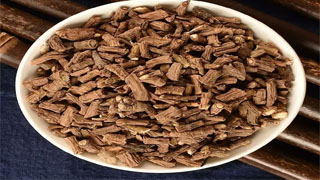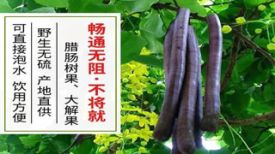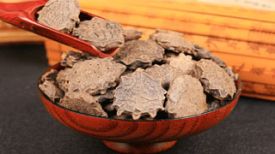
Chinese herbal medicine for clearing deficiency and heat, used for cold and fever, cold and heat exchange, malaria, liver depression and qi stagnation, chest and rib pain, prolapse, uterine shedding, and menstrual disorders. Chaihu was first recorded in the "Shennong Bencao Jing" and is classified as a top-grade herb. Throughout history, there have been many descriptions of the plant morphology of Bupleurum chinense in traditional Chinese medicine. The "Compendium of Materia Medica" records: "Chai Hu (Bupleurum chinense) can be found in the nearby areas of Guan, Shan, and Jianghu, with the one from Yinzhou being the winner. It grows in February and is very fragrant, with stems that are green and purple, and leaves that are slightly purple like bamboo leaves... In July, it blooms with yellow flowers... The roots are red and strong, like the front of the Hu tree. The head of the Lu has red fur like a rat's tail, and it is good to have a solitary nest. Roots are harvested in February and August." There are also five accompanying pictures. Among them, the Chaihu diagrams of Danzhou, Xiangzhou, and Zizhou, as well as the Chaihu diagram of Zhuye in the Compendium of Materia Medica and the Chaihu diagram of Jiuhuang Bencao, are all plants of the Chaihu genus.
[Nicknames] Dixun, Maohu (from the "Classic"), Shancai, Rucao (from the "Wupu Classic"), Chaicao (from the "Pin Hui Jing Yao").
【 Source 】 The roots of plants in the Umbelliferae family, such as Bupleurum chinense and Bupleurum chinense. Dig the roots during the spring and autumn seasons, remove the stems, seedlings, and soil, and dry them in the sun.
【 Form 】 ① Bupleurum chinense, also known as Zhuye Bupleurum chinense (from the "Plant Name and Reality Map Study"), Iron Seedling Bupleurum chinense, Grasshopper Leg, Mountain Root Vegetable, Black Bupleurum chinense, and Mountain Bupleurum chinense. Perennial herb, 45-70 cm tall. Root straight, divided or not divided. The stem is upright, clustered, with multiple branches in the upper part, and slightly curved in a zigzag shape. Mutual growth of leaves; Widely linear lanceolate, measuring 3-9 cm in length and 0.6-1.3 cm in width, with a gradually pointed tip that eventually forms a short awn shape. The entire margin is green above and light green below, with 7-9 parallel veins. Umbelliferae inflorescence axillary and terminal; Umbrella stem 4-10, length 1-4 centimeters, unequal in length; The bracts are missing or have 1-2 pieces; Small umbrella stem 5-10, about 2 millimeters long; Small bracts 5; Small flowers, yellow in color, with a diameter of about 1.5 millimeters; Calyx teeth are not obvious; Petals 5, with tips bent inward into 2 teeth; Stamen 5, anthers ovate; Pistil 1, ovary lower, smooth and hairless, style 2, extremely short. The double hanging fruit is oblong and elliptical in shape, flattened on both sides, about 3 millimeters long, with 5 distinct main edges for fruiting. There are usually 3 oil tubes in the groove and 4 oil tubes on the joint surface. The flowering period is from August to September. The fruiting period is from September to October. Born on dry barren slopes, fields, and roadsides. It is distributed in Jilin, Liaoning, Henan, Shandong, Anhui, Jiangsu, Zhejiang, Hubei, Sichuan, Shanxi, Shaanxi, Gansu, Xizang and other places.
② Narrow leaved Chaihu, also known as Red Chaihu or Fine leaved Chaihu. Perennial herb, 30-65 cm tall. The roots are deep and long, with no or slight divergence, and the outer skin is reddish brown. The stem has one or several branches, with multiple branches in the upper part, smooth and hairless. Mutual growth of leaves; The root bearing leaves and lower stem leaves have long stems; The leaves are linear or linear lanceolate, measuring 7-15 centimeters in length and 2-6 millimeters in width, with a pointed tip and 5-7 nearly parallel veins. Compound umbel inflorescence; Umbrella stem 3-15; The bracts are missing, or there are 2-3; Small umbrella stem 10-20, about 2 millimeters long; Small bracts 5; Small flowers, yellow: petals 5, apex inward folded; Stamen 5; Lower ovary, smooth and hairless. Double hanging fruit, oblong or oblong ovate in shape, 2-3 millimeters long, with 5 thick and blunt fruit edges. The oil tubes in the grooves of mature fruit are not obvious, while the transverse section of young fruit often has 3 oil tubes in each groove. The flowering period is from July to September. The fruiting period is from August to October. Born on dry grasslands. Distributed in Heilongjiang, Jilin, Liaoning, Inner Mongolia, Hebei, Shandong, Jiangsu, Anhui, Gansu, Qinghai, Xinjiang, Sichuan, Hubei and other places.
【 Characteristics 】 ① Bupleurum chinense, also known as Hard Bupleurum chinense. The root of the plant Bupleurum chinense with a few stems at the base. The root is conical in shape, with a straight or slightly curved main root and branching at the lower part. The root head is swollen and lumpy, measuring 6-20 centimeters in length and 0.6-1.5 centimeters in diameter. The outer skin is gray brown or gray brown, with longitudinal wrinkles and root support marks. The top has fine hairs or hard residual stems. The quality is relatively tough. Not easy to break, with a woody fibrous cross-section and a yellow white color. The aroma is slightly fragrant, and the taste is slightly bitter and spicy. It is better to have thick and long roots, thin skin, and few branches. Mainly produced in Liaoning, Gansu, Hebei, and Henan. In addition, it is also produced in Shaanxi, Inner Mongolia, Shandong and other places.
② South Chaihu, also known as Soft Chaihu (Compendium of Materia Medica) and Fragrant Chaihu. The root of the narrow leaved Bupleurum chinense plant. The appearance is similar to that of Bupleurum chinense, but the roots are thinner, have fewer branches, and are often bent and not straight. They are 4-10 centimeters long and 6-10 millimeters in diameter, with a reddish brown surface, longitudinal wrinkles, and fibrous root marks. There are no lumps on the top, and there are hairy fibers left after the death of the above ground stems and leaves. Crispy, easy to break, flat cross-section, light brown in color. The smell is the same as that of Bupleurum chinense. It is better to have thick and long roots without any unnecessary roots. Mainly produced in Hubei, Jiangsu, and Sichuan. In addition, it is also produced in Anhui, Heilongjiang, Jilin and other places.
[Processing] Chaihu: Pick out impurities, remove residual stems, wash sediment, remove, moisten and slice in a timely manner, then dry in the sun. Vinegar Chaihu: Take Chaihu slices, mix well with vinegar, stir fry in a pot over low heat until the vinegar is absorbed and slightly dried, remove and sun dry. (100 pounds of Bupleurum chinense, 12 pounds of vinegar) Turtle Blood Bupleurum chinense: Take Bupleurum chinense slices, place them in a large bowl, pour in a small amount of diluted turtle blood with warm water, mix well, moisten, put them in a snail and stir fry over low heat, remove and let cool. (For every 100 pounds of Bupleurum chinense, use 200 live turtles to collect blood)
[Taste] Bitter, cool.
[Gui Jing] Enters the liver and gallbladder meridians.
【 Effect 】 Reconciliation of the exterior and interior, soothing the liver, and promoting yang. Treat cold and heat exchange, chest and rib pain, bitter mouth and hearing loss, headache and dizziness, malaria, prolapse, menstrual disorders, and uterine prolapse.
【 Attention 】 Do not take it if there is a loss of true yin and an increase in liver yang.
① Pinellia ternata is his envoy. He hates soapberry pods. He fears the beauty of women's flowers and the fruit of the vine
② Introduction to Medicine: "Those who have lost their vital energy and sweat profusely due to Yin fire will die if taken by mistake
③ The "Compendium of Materia Medica" states: "Patients with deficiency and rising qi should avoid it, and those with vomiting, Yin deficiency, and excessive heat should also avoid it according to the law. Malaria should not be eaten by those who are not in the Shaoyang meridian
【 Prescriptions 】 1. Treat typhoid fever for five or six days, stroke, cold and hot movements, chest and rib pain, aversion to food, restlessness and nausea, or chest discomfort but no nausea, thirst, abdominal pain, rib pain, palpitations, difficulty urinating, mild fever, or cough: half a pound of Bupleurum chinense, three liang of Scutellaria baicalensis, three liang of Panax ginseng, half a liter of Pinellia ternata (washed), three liang of licorice (roasted), three liang of ginger (cut), and twelve jujubes (broken). Add seven flavors, take one bucket of water and two liters, boil for six liters, remove impurities, and then fry for three liters. Warm clothing one liter, three servings per day. (Xiao Chai Hu Tang from "Treatise on Cold Damage")
2. At the beginning of treating typhoid fever, I felt a fever, headache, and foot pain: half a liang of Chaihu (removing seedlings), one piece of Huangqin (removing black heart), and one piece of Jingjie ear each. Top three flavors, filed like sesame beans. Take five taels of dagger per serving, one and a half cups of water, ginger and one jujube big (crushed), fry until 80%, remove impurities, add a mixture of raw earth juice, half a tablespoon of white honey, boil for three to five times, and take hot. (Detoxification Soup in the General Record of St. Francis)
3. For the treatment of external wind cold, fever and chills, headache and body pain, and the onset of malaria: 5-15g Chaihu, 5g Fangfeng, 7.5g Chenpi, 10g Shaoyao, 5g Licorice, and 3-5 slices of ginger. Water for one and a half minutes, fry for seven or eight minutes. Hot clothing. (The Complete Book of Jingyue: Chaihu Drink)
4. Febrile fever, headache and body pain, dry and thirsty mouth: 50 grams each of gypsum, Scutellaria baicalensis, licorice, Paeonia lactiflora, and Pueraria lobata, 25 grams each of ephedra (without nodes) and Bupleurum chinense (without seedlings). Smash the dough into powder. A three-year-old child should take 5 grams each, a small cup of water, a little ginger, 3 inches of scallion, and 20 pieces of black beans. Fry them together until they reach 5%, and filter out the residue. Warm clothing, regardless of the time, sweat is effective. Add or subtract the size of the quantity. (Chai Hu San in the "Bureau Formula")
5. Too many days of treating typhoid fever, feeling stuffy or painful in the heart, talking uncontrollably, restless and unable to sleep, and unable to urinate and defecate: 50g of Chaihu (removing seedlings), 50g of rhubarb, 50g of plain nitrate, 25g of licorice, and 50g of Fructus Aurantii (removing dampness). The top five flavors are the last. Take 15 grams per serving, three cups of water, and fry until 6%. Warm clothing, only two servings per day, not more. Wait for urination and defecation to pass, which means sweating naturally. ("Boji Formula" Chaihu Powder)
6. Treating pregnant women with cold and hot headaches, aversion to food, lower back pain, nausea and phlegm reflux; Postpartum cold, heat entering the uterus, cold and heat like malaria, and intermittent water flow; After recovery from illness, the residual heat remains unclear: 50g of Bupleurum chinense, 0.75g of Scutellaria baicalensis, ginseng, and licorice (roasted) each. The file is as big as sesame beans. Take 25 grams per serving, one and a half cups of water, boil one cup, remove impurities, and take warm clothing. (Yellow Dragon Soup in "The Book of Living People with Similar Evidence")
7. To treat pulmonary malaria and relieve restlessness and nausea: 50g of Anemarrhena, 100g of Bupleurum chinense (without seedlings), 50g of ginseng (without reed heads), 25g of licorice (roasted slightly red, filed), 50g of Ophiopogon japonicus (without heart), 50g of almonds (soaked in soup, peeled, pointed, and double kernels, stir fried with bran slightly yellow). Take the medicine and grind it into powder. Take 20 grams per serving, take one cup of water, fry until six minutes, remove impurities, and warm up regardless of time. (Holy Blessing Formula)
8. To treat malaria, there is more cold and less heat, and bloating: 10 grams each of Chaihu, Banxia, Houpu, and Chenpi. Two bowls of water, fry for eight minutes. Dress up at any time. (Compendium of Materia Medica)
9. To treat rib pain, cold and heat exchange: 10g of Bupleurum chinense, 7.5g of Chuanxiong, Fructus Aurantii (stir fried with bran), and Paeonia lactiflora each, 2.5g of Licorice (roasted), and 7.5g of Aconitum carmichaelii. Water for one and a half minutes, fry for eight minutes. Take before meals. (Chaihu Shugan San from "Jingyue Quanshu")
10. Treatment for jaundice: 50g Chaihu (without seedlings), 0.5g Licorice. Make a fine file on the top, take a bowl of water, hold a handful of white thatch roots, and fry together until 70%, then grind off the residue. Serve anytime, finish in one day. (Sun Shang's Prescription)
11. Treatment for liver jaundice, blue complexion, limb tightness, dry mouth and tongue, awkward speech, blue claws: 50g Bupleurum chinense (removed from seedlings), 25g Licorice (roasted slightly red, filed), 25g Cassia seed, 25g Plantago asiatica, and half a liang of antelope antler shavings. Take the medicine and grind it into powder. Take 15 grams per serving, take one cup of water, fry until 5%, remove impurities, and warm up regardless of the time. ("Shenghui Formula" Chaihu Powder).
⊙ The content of the article is for clinical reference only. Non TCM professionals are not allowed to test drugs.


